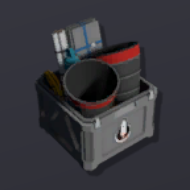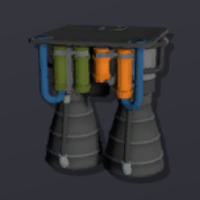Pressure Fed Gas Engine
From Unofficial Stationeers Wiki
 | |
| Fabrication | |
|---|---|
| Created with | Rocket Manufactory (Tier One) |
| Cost | 60000 Energy, 20g Steel, 5g Electrum, 20g Invar, 10g Constantan |
| Temperature | |
| Flashpoint | 373K (100°C) |
| Autoignition | 573K (300°C) |
| Other properties | |
| Paintable | Yes |
| Stack Size | 1 |
| Prefabs | |
| Prefab Hash | -121514007 |
| Prefab Name | ItemKitPressureFedGasEngine |
Description[edit]
"Inefficient but very powerful, the Pressure Fed Gas Engine moves gas from each of its two inputs based on the pressure of the input pipes. Control the mixing ratio of fuel by tweaking the input pressures to a target 2:1 mix of Liquid Volatiles to Liquid Oxygen gas. Chilling propellant gasses or using Liquid Nitrous Oxide as an oxydizer will result in even higher trhust outputs."
- Stationpedia
Comparison[edit]
Rocket Engines give you their max output in kN with this you can calculate what they can reasonably carry into orbit depending on the planet or moon you are on. Force = Mass * Acceleration. Acceleration is equal to the planet's gravity, Mass is given in kg per part of the rocket, and Force is kN. If your thrust force listed below is less than the weight of the rocket in kN then you will not even take off. It is better to have a thrust much higher than the weight of the rocket or else you risk running out of fuel on launch and on landing.
Liquid propellants bring greater efficiencies. Using Nitrous Oxide as oxidizer provides excessive thrust values. Keep in mind that N2O fuel mix is 1.9375 times heavier at same moles, or 2.15 times heavier at same volume, while thrust boost is around 1.5-1.7. Engine efficiency determines "bonus" thrust multiplier, meaning engine with higher efficiency will give more thrust consuming same amount of fuel. Thus using liquid engines is more favorable if one can cool fuel down, moreover Pressure Fed Engines consume fuel inversely proportional to its temperature. On the other hand if Volatiles and Oxygen are in excess (e.g. farm on Vulcan) is may be much easier to opt for Pressure Fed Gas Engine. It will provide ~40kN at 20°C.
| Name | Base Power Usage | Rocket Mass Contribution | Max Thrust | Real Max Thrust | Efficiency | Exhaust Velocity | |
|---|---|---|---|---|---|---|---|
| Using O2 | Using N2O | ||||||
| Pressure Fed Gas Engine | 10W | 500kg | 40,3kN | 61,0kN | 41,9kN[1] | 96% | 3,86km/s (Isp: 394s) |
| Pumped Gas Engine | 200W | 500kg | 16,2kN | 16,5kN | 24,5kN | 100% | 4,02km/s (Isp: 411s) |
| Pumped Liquid Engine | 200W | 500kg | 17,6kN | 18,7kN | 31,3kN | 140% | 5,47km/s (Isp: 559s) |
| Pressure Fed Liquid Engine | 20W | 500kg | 29,2kN | 43,4kN - 38,1kN | 74,5kN - 61,3kN | 160% | 6,18km/s (Isp: 631s) |
| Update 0.2.4726.21691 - 18/01/2024 Rocket_Engines | |||||||
Controversy[edit]
This engine is controversially discussed among stationeers as possibly beeing the best choise of engine, but it depends on the use case. If using Liquid Nitrous Oxide as an oxydizer, it will most likely liquify in the tanks andor pipes and make your rocket go boom.
Usage[edit]
To make the rocket work, use 2 Volume Pumps, 2 Pipe Analyzers and a IC10 Script to keep the Pressure up. Maybe don't build this rocket if it's your first one.
The ideal pressure of the intake pipes is not a fixed number; it depends on the size and weight of your rocket and needs to be determined either mathematically or by trial and error.
Control[edit]
Setup that proves to work nicely:
define ATMOSMODEVOLPRESSURE 10000
define ATMOSMODEOXYPRESSURE 5000
define FULLMODEVOLPRESSURE 54000
define FULLMODEOXYPRESSURE 27000
define LOWTHROTTLETHRESHOLD 60 # the rocket is possibly landing when Throttle is lower that
Define Constants and Variables:[edit]
Pressure Settings: Determine and define the pressure values for both atmosphere and full mode. These will be used to control the pressure of the gases in the system.
Engine Parameters: Identify key parameters such as throttle thresholds and engine hash identifiers.
Initialize Components:
Enable Components: Turn on the necessary components like Volume Pumps and Pipe Analyzers to ensure they are functioning correctly.
Set Up Variables: Initialize variables for tracking current values like thrust-to-weight ratio and throttle.
Monitor Engine State[edit]
Measure Thrust-to-Weight Ratio: Continuously check the current thrust-to-weight ratio to determine the operating state of the rocket.
Throttle Levels Monitor the current throttle level to determine if the rocket is under high or low throttle conditions.
Throttle[edit]
Low Throttle Condition If the throttle is below a certain threshold, this usually indicates the rocket might be landing or in a low-power state. Adjust the pressure settings accordingly.
High Throttle Condition For high throttle, maintain or adjust the pressure settings to ensure optimal performance and efficiency.
Pressure Adjustment Logic[edit]
Atmosphere Mode Set the pressure values for gas inputs to match the atmospheric conditions. This involves checking if the pressure is too high or too low and adjusting the volume pumps accordingly.
Full Mode When the rocket is in full power mode (e.g., during Takeoff or possibly landing), adjust the pressures to higher values to optimize thrust.
Control Loop[edit]
Continuous Monitoring The script should continuously loop, checking and adjusting the pressure settings based on the current state of the rocket. This ensures the rocket operates efficiently throughout its journey.
Handling Pressure Adjustments[edit]
Adjust Pumps: Depending on the current pressure readings, activate or deactivate pumps and set their volumes to reach the desired pressure levels.
Update Settings: Make real-time adjustments to the pump settings to maintain the appropriate pressure levels for both atmosphere and space conditions.
Data Network Properties[edit]
Input Data (Write)[edit]
| Parameter Name | Data Type | Value | Description |
|---|---|---|---|
| On | Boolean | 0 | Turns the device off. |
| 1 | Turns the device on. | ||
| Setting | int | A variable setting that can be read or written, depending on the device. | |
| Throttle | int | Increases the rate at which the machine workes (range: 0-100) | |
| Update 0.2.4726.21691 - 19/01/2024 /Data_Network | |||
Output Data (Read)[edit]
| Parameter Name | Data Type | Value | Description |
|---|---|---|---|
| Power | Boolean | Can be read to return if the device is correctly powered or not, set cia the power system, return 1 if powered and 0 if not. | |
| Error | Boolean | 1 if device is in error state, otherwise 0. | |
| Pressure | int | The current pressure reading of the device. | |
| Temperature | int | The current temperature reading of the device. | |
| Setting | int | A variable setting that can be read or written, depending on the device. | |
| RatioOxygen | int | The ratio of Oxygen in device atmosphere. | |
| RatioCarbonDioxide | int | The ratio of Carbon Dioxide in device atmosphere. | |
| RatioNitrogen | int | The ratio of Nitrogen in device atmosphere. | |
| RatioPollutant | int | The ratio of Pollutant in device atmosphere. | |
| RatioVolatiles | int | The ratio of Volatiles in device atmosphere. | |
| RatioVolatiles | int | The ratio of water in device atmosphere. | |
| Maximum | int | Maximum setting of the device. | |
| Ratio | int | Context specific value depending on device, 0 to 1 based ratio. | |
| Ratio | Boolean | The current state of the device, 0 for off, 1 for on. | |
| RequiredPower | int | Idle operating power quantity, does not nevessarily include extra demand power. | |
| TotalMoles | int | Returns the total moles of the device. | |
| RatioNitrousOxide | int | The ratio of Nitrous Oxide in device atmosphere. | |
| PrefabHash | int | The hash of the structure. | |
| Combustion | Boolean | The assess atmosphere is on fire. Returns 1 if atmosphere is on fire, 0 if not. | |
| Throttle | int | Increases the rate at which the machie works (range: 0-100) | |
| ReferenceId | Unique Reference Identifier for this object. | ||
| PassedMoles | int | The number of moles that passed through this device on the previous simulation tick. | |
| Update 0.2.4726.21691 - 19/01/2024 /Data_Network | |||
Build States[edit]
- ↑ N2O must be much hotter to avoid condensing therefore decreasing pumping rate

